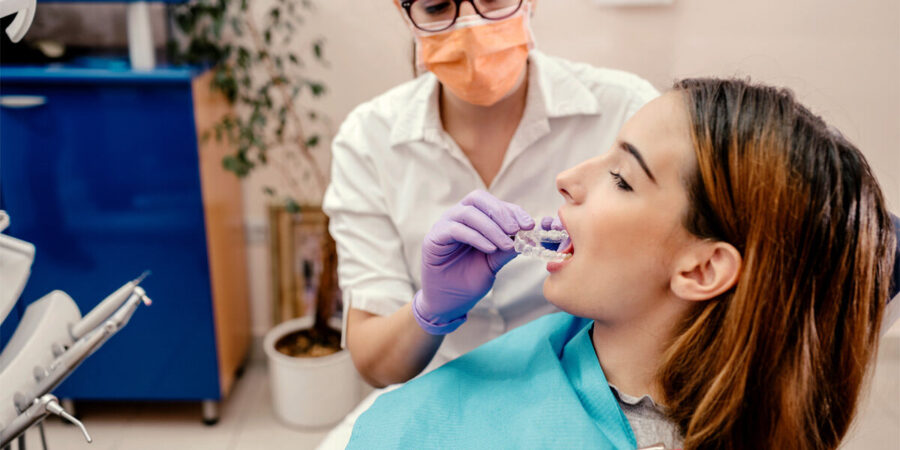CLEARLY A GOOD CHOICE! ARE CLEAR ALIGNERS THE RIGHT CHOICE FOR YOU?
Clear aligners can help patients straighten their teeth invisibly.
Many adult orthodontic patients once dreamed of having a beautiful, straight smile. For one reason or another, they were never able to commit to orthodontic treatment as kids. Maybe their parents couldn’t afford braces or perhaps they did have braces as a child but didn’t wear a proper retainer. Sometimes just the thought of feeling self-conscious while enduring two years in metal brackets is too overwhelming. Regardless of the reason, adults are signing up for orthodontics like never before. Actually, over 25% of patients in orthodontic treatment are adults!
Straight, bright-white teeth are a symbol of youth and vitality. Thanks to advances in dental science and technology, many folks can now get these results in a fraction of the time compared to traditional metal braces.
There are still many cases where metal braces and a two-year treatment commitment are the best solutions, but clear aligners can help many adults have the smile of their dreams in a few simple steps.
Clear aligners have many brand names like Invisalign or SureSmile. They are made of a clear, thermoplastic tray that patients wear for up to 22 hours a day and only removed while eating or drinking. Each brand has its pros, but they are mostly the same and really just a choice the dentist makes on which brand to use.
After an exam, x-rays, photographs, and digital scans, your dentist send this information off to a designated orthodontic lab. The lab will design your new smile and fabricate a set of trays. The trays have small “buttons” where the plastic is built up. These buttons create points of pressure on specific teeth and encourage them to shift into position. Each set of trays is worn for a couple of weeks at a time. When the teeth have moved to the point that no pressure is felt on any single tooth, the next set of trays is inserted and worn for another few weeks. This routine continues until the teeth are moved into their ideal place. Like traditional braces, a retainer is worn after your active treatment phase is over to maintain the results (and yes, that’s a retainer forever).
Clear aligners are great for adults and some mature teens but are not recommended for children because they can be easily removed and lost.
A brief consultation and exam with your dentist can help determine if clear aligners are right for you. Sometimes your dentist can even show what your smile will look like when treatment is complete even before you begin!
Whether you have always dreamed of a beautiful, straight smile or just recently given it some thought, give us a call to see if clear aligners can work for you!
NO SUGAR BUGS HERE: HOW TO PREVENT DECAY IN YOUR TODDLERS MOUTH!
Preventing tooth decay in toddlers can help them later in life.
The American Academy of Pediatric Dentistry (AAPD) estimates that by age four almost 25% of children have, or have had, a cavity. Tooth decay occurs when bacteria in the mouth fed by sugar, flourish and destroy the enamel of the teeth. Poor brushing habits and a sugary diet can contribute to tooth decay.
Tooth decay in toddlers is a real problem because they lack the coordination to brush their teeth thoroughly on their own and naturally have a diet that is higher in sugars compared to adults. Some toddlers can be picky eaters and these dietary restrictions can make for a limited diet full of starchy, sugary foods.
Here are some tips to prevent early childhood tooth decay:
1. VISIT THE DENTIST
Have your baby’s mouth examined at the appearance of the first tooth or by their first birthday (whichever comes first). Dentists and dental hygienists are trained to look for early signs of tooth decay and can have important discussions about nutrition. They will also discuss the tools that are best to clean your little ones’ teeth.
2. KEEP CLEAN AT HOME Start cleaning your infant’s mouth after each feeding by wiping gums with a soft cloth. No solids and no teeth doesn’t mean cleaning is not important. Keeping the pH of the mouth balanced is important even in the absence of teeth.
3. CAN THE BEDTIME BOTTLES Don’t let your baby or toddler go to bed with a bottle, a sippy cup of juice, or milk. Sugars bathe the teeth and alter oral pH. If left to sit all night, can cause baby bottle tooth decay.
4. CREATE GOOD DIET HABITS Limit foods that are acidic, starchy, sticky, or sugary. Examples include are oranges, soft cheeses, fruit snacks, and cookies. While they can all be enjoyed in moderation, these foods can erode tooth enamel or stick to teeth, allowing the bacteria-eating sugar to eat through tooth enamel.
5. LET THE BRUSHING BEGIN Help your child brush their teeth with a soft-bristled toothbrush specially made for a child’s smaller mouth. You should help them brush twice a day for two minutes while holding the brush at a 45-degree angle. If your child will tolerate an electric toothbrush, then go for it!
6. INTRODUCE FLUORIDE WHEN APPROPRIATE Avoid using a fluoridated toothpaste until your little one is two years old or able to spit without swallowing fluoridated toothpaste. Children under two should use a rice-sized strip of toothpaste. For older children, a pea-sized amount is appropriate.
What do you do if, despite your best efforts, your child develops a cavity?
The American Academy of Pediatric Dentistry (AAPD) recommends restoring a decayed tooth with a filling or a small crown and waiting for the tooth to fall out on schedule. This will prevent the bacteria from spreading to other teeth, growing decay on an unerupted tooth.
A severely decayed tooth may have to be extracted, but this is avoided if possible because baby teeth hold the place for unerupted adult teeth and help the jaw develop in its proper position.
As a parent, lay groundwork for your child’s diet and oral hygiene habits for the rest of their life. Establishing good oral health habits at an early age will prevent tooth decay in their baby teeth and the habits your child learns will stick with them throughout their life. With a proper dental home and guidance from a dentist, you can help your child go from childhood to adolescence without ever having to hear the buzz of a dentist’s drill.

